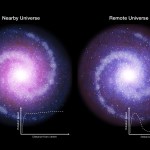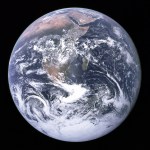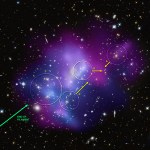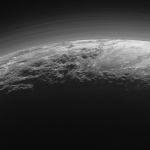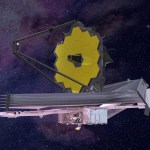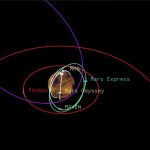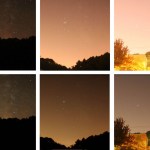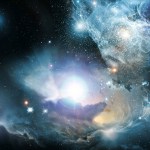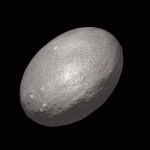Astronomy
"Dark matter or invisible element?
You decide." -Toba Beta
The dark matter wars rage on and on, with both sides -- those in favor of modifying gravity and those in favor of adding an additional mass component to the Universe -- claiming victories for their own side and defeat for the other. But one piece of evidence, hitherto elusive, might finally hold the key to distinguishing one from the other: early, young, less-evolved galaxies. Billions of years ago, not as much dark matter had fallen into the inner portions of galaxies, meaning that the outer portions of rotating spirals should…
"With the Hubble telescope and all the other things that are out there, I believe something would have come through. Today, I really believe we are unique." -Mark Goddard
Want to identify where stars are forming (or about to form) in the Universe? We’ve got no problem using visible light, which reveals unambiguous signatures associated with newborn stars. But if you want to view those stars themselves, or the processes occurring within the nebula where they’re being born? You have to go to infrared light.
Taken in infrared light, the image shows the dense column and the surrounding greenish-…
"I put up my thumb and shut one eye, and my thumb blotted out the planet Earth. I didn't feel like a giant. I felt very, very small." -Neil Armstrong
The full Moon is undoubtedly bright. As viewed from the Earth’s surface, it’s the second brightest object of all, after the Sun, and is more than 1,500 times brighter than Venus. In fact, the full Moon is over 40 times brighter than the entire rest of the night sky combined, and can outshine even a big city when seen right next to one.
The rising full Moon and the city of Chicago, as viewed over Lake Michigan from Northwestern University's…
“We are told to let our light shine, and if it does, we won’t need to tell anybody it does. Lighthouses don’t fire cannons to call attention to their shining- they just shine.” -Dwight L. Moody
The farther away in space we look, the farther back in time we’re seeing. Light arriving from a star ten light years away is ten years old; light that took a billion-year journey from a distant galaxy is a billion years old. If we look out today at the most distant light we can see, we discover that it originates from the Big Bang itself: the Cosmic Microwave Background, or CMB.
The timeline of our…
"On a cosmic scale, our life is insignificant, yet this brief period when we appear in the world is the time in which all meaningful questions arise." -Paul Ricoeur
When it comes to the largest bound cosmic structures, it doesn’t get any bigger than galaxy clusters. Unless, that it, you consider when multiple galaxy clusters merge together. Located at the intersections of cosmic dark matter filaments, smaller clusters flow into the larger clusters located at such a nexus. When we get very lucky, colliding clusters can be seen.
The combination of radio and X-ray data reveal background, lensed…
"Laws of nature mixed with evolutionary/historical contingencies allow for a range of diversity... [t]hat diversity, within the laws of nature, when I step back a bit from the desk or the computer, still surprises me to no end." -Adrian Lenardic
When it comes to the habitability of a planet, there are a lot of assumptions that we make. All of them boil down to, at some level or other, how Earth-like this world is. This is reflected in our language: terms like “super-Earth” or “habitable zone” showcase this inherent bias. Yet the vast majority of stars that are out there aren’t Sun-like,…
"One should not need a teleportation device to decide whether a newly discovered object is a planet." -Jean-Luc Margot
It was a harsh lesson in astronomy for all of us in 2006, when the International Astronomical Union released their official definition of a planet. While the innermost eight planets made the cut, Pluto did not. But given the discovery of large numbers of worlds in the Kuiper belt and beyond our Solar System, it became clear that we needed something even more than what the IAU gave us.
This diagram compares the sizes of the newly-discovered planets around the faint red star…
"For the first time we can learn about individual stars from near the beginning of time. There are surely many more out there." -Neil Gehrels
We know what NASA’s James Webb and WFIRST are designed for, and we know what we expect to find. James Webb will be the largest space telescope ever, focused mostly on infrared observations probing exoplanets, star-forming nebulae, galaxy evolution and the first stars and galaxies in the Universe. WFIRST will be just like Hubble, except with better instruments and 100 times the field-of-view.
The Hubble eXtreme Deep Field, our deepest view of the…
"If we get rid of the moon, women, those menstrual cycles are governed by the moon, will not get PMS. They will stop bitching and whining." -Joe Scarborough, misattributing a quote to Arnold Schwarzenegger that was actually spoken by an impersonator
Our Moon is pretty unusual as far as the Solar System goes: of all the planets, our Moon has the largest mass and radius ratios when compared to its parent planet. It’s enough to not only illuminate our night sky quite fiercely -- the full Moon is 14,000 times brighter than the next brightest object in the night sky -- but it has some significant…
"The [James Webb] telescope is basically designed to answer the big questions in astronomy, the questions Hubble can't answer." -Amber Straughn
Have you ever asked the biggest questions in the Universe? Questions like how the Universe came to be the way it is today? How the first stars and galaxies -- the first light -- came to be in the Universe? Whether Earth-sized worlds around red dwarf stars have atmospheres, possibly with signatures of life? And what the Universe was like when the first stars were just forming? The James Webb Space Telescope was designed to answer these questions and…
“I didn't even know there were stars to look at to not see. If you don't know that they're there, you don't know that you're missing them.” -Neil deGrasse Tyson, on light pollution
As with pretty much every week that goes by, we've had a slew of fantastic stories here at Starts With A Bang! There have also been events galore, including two public talks on gravitational waves and the controversy over the expanding Universe, and many upcoming events, including:
March 9th: talks and events at Jacksonville University in FL,
March 24-26: appearances and panels at MidSouthCon in Memphis…
As more and more exoplanets (at first) and earth-like exoplanets (eventually) have been discovered, the way thy are described to us has become increasingly sophisticated. Below are embeds of diverse video descriptions that have been very quickly developed and distributed given the freshness of this latest scientific discovery. Note that the practice of very clearly stating that a particular depiction of something that no human has ever seen, or will ever see, as being an artist's reconstruction has largely fallen by the wayside. Exoplanets are no longer physical features of the universe…
"It isn't only the beauty of the night sky that thrills me. It's the sense I have that some of those points of light are the home stars of beings not so different from us, daily cares and all. who look across space with wonder, just as we do." -Frank Drake
What is it that makes our Solar System special? It’s Earth, of course. A rocky planet of the right mass and composition, the right distance from our Sun, the right atmosphere, the surface oceans, and all the life that’s ensued is what makes us special. Not just special, but unique, at least among the planets we’ve found so far.
The orbits…
"The larger inner moons fall back to Mars after about 5 million years due to the tidal pull of the planet, after which the two outer satellites evolve into Phobos- and Deimos-like orbits." -Pascal Rosenblatt, et al.
Compared to the other moons we know of in the Solar System, Mars’s two, Phobos and Deimos, are incredibly difficult to explain. They look like captured asteroids, being small, irregular, and exhibiting the right surface features. But captured asteroids form inclined or even retrograde orbits quite distant from their planet, while Phobos and Deimos live in circular,…
"Before we devised artificial lights and atmospheric pollution and modern forms of nocturnal entertainment we watched the stars. There were practical calendar reasons of course but there was more to it than that. Even today the most jaded city dweller can be unexpectedly moved upon encountering a clear night sky studded with thousands of twinkling stars. When it happens to me after all these years it still takes my breath away." -Carl Sagan
For all of human history, we’ve battled against the limitations of our bodies and the natural world. That’s led to the development of artificial lighting…
"It is the function of science to discover the existence of a general reign of order in nature and to find the causes governing this order. And this refers in equal measure to the relations of man - social and political - and to the entire universe as a whole." -Dmitri Mendeleev
When the Universe was first born, all we had was hydrogen and helium, with a trace amount of lithium and absolutely nothing else. 13.8 billion years later, hydrogen is still #1 in the Universe and helium is still #2, but lithium isn’t close to #3 anymore: more than two dozen elements have passed it. The key? Stars!…
"How vast those Orbs must be, and how inconsiderable this Earth, the Theatre upon which all our mighty Designs, all our Navigations, and all our Wars are transacted, is when compared to them." -Christiaan Huygens
It was quite a surprise when we started discovering all the exoplanets that were out there. While there’s a big gap between a world like Earth and a world like Uranus or Neptune in our Solar System – 17 times the mass and 4 times the radius – most of the worlds out there fall in between these two types. Super-Earths and Mini-Neptunes are the most common.
The numbers of planets…
"'I'll follow him to the ends of the earth,' she sobbed. Yes, darling. But the earth doesn't have any ends." -Tom Robbins
We have some pretty good definitions of what it takes to be a planet, and one part of that definition is that a world needs to be massive enough to pull itself into hydrostatic equilibrium. In the absence of external forces and rotation, that means it will be a perfect sphere.
The line for a planet vs. a non-planet is mass-dependent, and making a thin, rigid body fails on that account. You can have a flat "thing" in space, but it wouldn't be a planet if you did. Image…
"The problem is, you’re trying to find these really faint things, but you’re looking behind these really bright things. The brightest galaxies in the universe are in clusters, and those cluster galaxies are blocking the background galaxies we’re trying to observe." -Rachael Livermore
One of the biggest puzzles in science is exactly how the Universe became transparent to visible light. Neutral atoms -- cosmic dust -- blocks visible light, and yet before there were stars, that’s all we had. According to theory, it should be large numbers of small, faint, ultra-distant galaxies that made it…
"To know that we know what we know, and to know that we do not know what we do not know, that is true knowledge." -Nicolaus Copernicus
As we peel back the layers of information deeper and deeper into the Universe’s history, we uncover progressively more knowledge about how everything we know today came to be. The discovery of distant galaxies and their redshifts led to expanding Universe, which led to the Big Bang and the discovery of very early phases like the cosmic microwave background and big bang nucleosynthesis.
The history of the Universe, as far back as we can see using a variety of…
